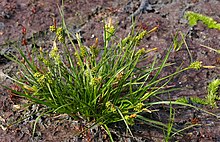Carex viridula
| Carex viridula | |
|---|---|

| |
| Carex viridula var. viridula | |
| Scientific classification | |
| Kingdom: | Plantae |
| Clade: | Tracheophytes |
| Clade: | Angiosperms |
| Clade: | Monocots |
| Clade: | Commelinids |
| Order: | Poales |
| Family: | Cyperaceae |
| Genus: | Carex |
| Section: | Carex sect. Ceratocystis |
| Species: | C. viridula
|
| Binomial name | |
| Carex viridula | |
Carex viridula, known as little green sedge, green sedge, or greenish sedge, is a small flowering plant native to North America, Europe, Asia, and Morocco.[2]
Taxonomy
[edit]Carex viridula is in the section Carex sect. Ceratocystis, a circumboreal group with around six other species, although the taxonomy of this group is controversial, and up to 19 species have been recognized.[3][4]
Flora of North America accepts the following three subspecies and two varieties of Carex viridula:[2][5]
- Carex viridula subsp. brachyrrhyncha
- Carex viridula var. elatior
- Carex viridula var. saxilittoralis
- Carex viridula subsp. oedocarpa
- Carex viridula subsp. viridula
As of December 2019[update], Kew's Plants of the World Online lists Carex viridula as a synonym of Carex oederi.[6]
There is also variety Carex viridula var. bergrothii (Palmgr.) B.Schmid (synonym Carex bergrothii Palmgr.).[7]
Conservation status
[edit]It is listed as endangered in Connecticut[8] and Pennsylvania.[9] It is listed as threatened in Illinois.[9]
References
[edit]- ^ NatureServe (3 December 2022). "Carex viridula Little Green Sedge". NatureServe Explorer (explorer.natureserve.org). NatureServe. Retrieved 29 December 2022.
- ^ a b Crins, William J. (2002). "Carex viridula". In Flora of North America Editorial Committee (ed.). Flora of North America North of Mexico (FNA). Vol. 23. New York and Oxford: Oxford University Press. Retrieved 20 December 2019 – via eFloras.org, Missouri Botanical Garden, St. Louis, MO & Harvard University Herbaria, Cambridge, MA.
- ^ Crins, William J. (2002). "Carex sect. Ceratocystis". In Flora of North America Editorial Committee (ed.). Flora of North America North of Mexico (FNA). Vol. 23. New York and Oxford: Oxford University Press. Retrieved 20 December 2019 – via eFloras.org, Missouri Botanical Garden, St. Louis, MO & Harvard University Herbaria, Cambridge, MA.
- ^ Jiménez-Mejías, Pedro; Luceño, Modesto; Martín-Bravo, Santiago (1 May 2014). "Species boundaries within the southwest Old World populations of the Carex flava group (Cyperaceae)". Systematic Botany. 39 (1): 117–131. doi:10.1600/036364414X677973. JSTOR 24546124. S2CID 85265989 – via ResearchGate.
- ^
- i. Crins, William J.; Ball, Peter W. (January 1988). "Sectional limits and phylogenetic considerations in Carex section Ceratocystis (Cyperaceae)". Brittonia. 40 (1): 38–47. doi:10.2307/2806873. JSTOR 2806873. S2CID 39085479 – via ResearchGate.
- ii. Crins, William J.; Ball, Peter W. (April 1989). "Taxonomy of the Carex flava complex (Cyperaceae) in North America and northern Eurasia. II. Taxonomic treatment". Canadian Journal of Botany. 67 (4): 1048–1065. doi:10.1139/b89-138 – via ResearchGate.
- ^ "Carex viridula". Plants of the World Online. Royal Botanic Gardens, Kew. Retrieved 20 December 2019.
- ^ "Carex bergrothii Palmgr". www.worldfloraonline.org. Retrieved 6 February 2021.
- ^ "Connecticut's Endangered, Threatened and Special Concern Species 2015" (PDF). State of Connecticut Department of Energy and Environmental Protection Bureau of Natural Resources. Retrieved 19 December 2019.
- ^ a b NRCS (2014). "Carex viridula". PLANTS Database. United States Department of Agriculture (USDA). Retrieved 19 December 2019.

